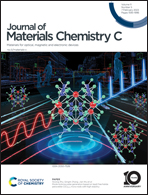A refractory metal-based photonic narrowband emitter for thermophotovoltaic energy conversion†
Abstract
Thermophotovoltaics is a promising technology for heat recovery and has garnered tremendous attention in the past decades. In a thermophotovoltaic system, a selective emitter is required to convert the incoming light in order to emit appropriate photons matched with the bandgap of the PV cell, both avoiding low-energy useless photons and thermalization loss caused by high-energy photons. This work aims to design a metal-based photonic narrowband emitter, and it is composed of tungsten, a refractory material which can withstand the high working temperature of the thermophotovoltaic system. Besides, the advantage of an all-metal emitter is that there is no concern of thermal expansion mismatch. Hexagon and square patterned arrays are numerically analyzed and a parametric study is conducted for different feature sizes, gaps, and pattern heights, leading to an emission peak shift and bandwidth change. Besides, a photonic metal-based emitter is fabricated using a photolithography method, optically characterized and compared with the calculated emissivity spectra. This work sheds light on the research of high-temperature thermal management, energy harvesting and power generation.



 Please wait while we load your content...
Please wait while we load your content...
